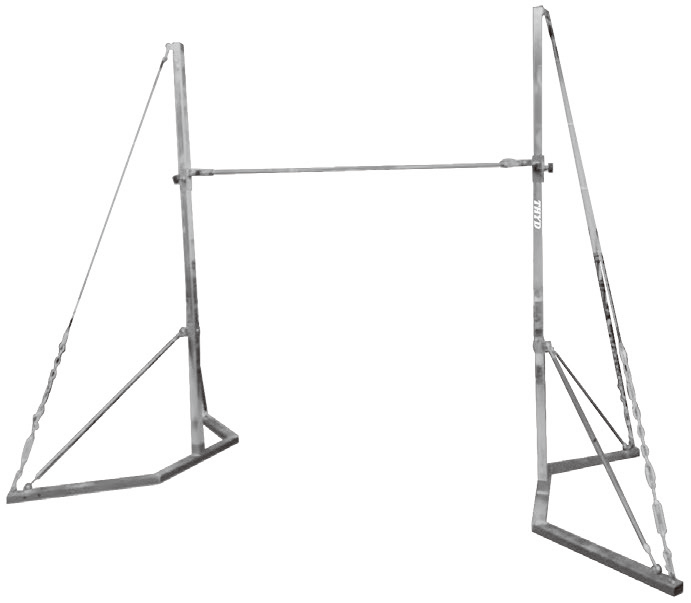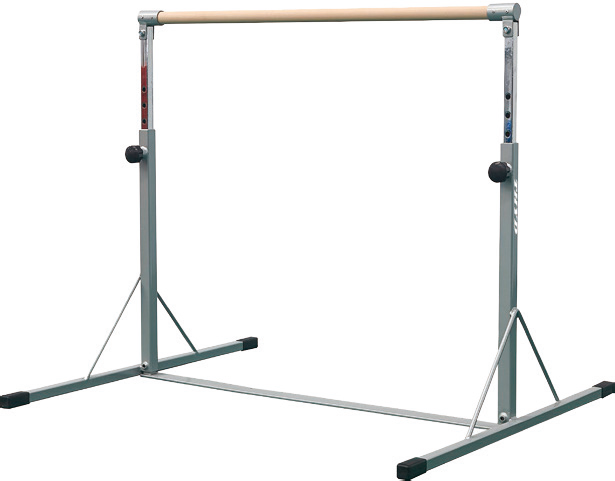How to Evaluate the Quality of a Gymnastics High Bar for Sale
A gymnastics high bar is a foundational piece of equipment for gymnasts, whether they’re beginners practicing basic swings or elite athletes performing complex releases and dismounts. The quality of a gymnastics high bar directly impacts safety, performance, and durability—making it critical to assess carefully before purchasing. A poorly constructed high bar can wobble during use, fail under pressure, or cause injuries, while a high-quality model provides stable support, smooth rotation, and long-term reliability. Let’s explore the key factors to evaluate when assessing a gymnastics high bar for sale.
Check Material Strength and Durability
The materials used in a gymnastics high bar determine its ability to withstand repeated use, heavy loads, and the dynamic forces of gymnastics movements. Focus on the construction of the bar itself, the frame, and connecting components.
Bar Material
The horizontal bar (the part gymnasts grip) is the most critical component. High-quality gymnastics high bars use steel—specifically, high-tensile strength steel or chrome-plated steel. These materials offer:
- Strength: Steel resists bending or warping, even when 承受 (withstanding) the weight of a gymnast swinging or hanging.
- Smoothness: Chrome plating creates a sleek, low-friction surface that allows for fluid rotations and grips, reducing the risk of hand injuries.
- Corrosion resistance: Chrome or powder-coated finishes protect the bar from sweat, moisture, and rust, extending its lifespan.
Avoid gymnastics high bars with aluminum or low-grade steel bars, as they may dent, bend, or degrade quickly with regular use. The bar should also have a consistent diameter (typically 2.8 cm/1.1 inches for standard high bars) to ensure a secure grip.
Frame and Base Construction
The frame (vertical supports) and base of the gymnastics high bar provide stability. Look for:
- Heavy-gauge steel tubing for the frame, with a thickness of at least 2 mm. Thicker tubing reduces wobbling during intense routines.
- A wide, weighted base to prevent tipping. Competition-grade high bars often have a base width of 120 cm (47 inches) or more, with additional weight plates for stability.
- Reinforced welds at connection points (where the frame meets the base or bar). Welds should be smooth, uniform, and free of cracks—weak welds are a common failure point.
For portable or adjustable models, ensure the locking mechanisms (used to adjust height or fold the frame) are made of hardened steel, not plastic, to prevent slipping during use.
Assess Stability and Rigidity
A gymnastics high bar must remain stable during even the most dynamic movements, from basic kips to advanced releases. Wobbling or shifting can throw off a gymnast’s balance, leading to falls or incomplete skills.
Static Stability
Test the stability of the gymnastics high bar when it’s stationary:
- Rock the base gently to check for movement. A quality high bar should stay firmly in place, with no noticeable shifting.
- Check for level using a spirit level. The bar should be perfectly horizontal, and the base should sit evenly on the floor—unevenness can cause uneven weight distribution and instability.
For floor-mounted high bars (permanently installed), ensure the anchor bolts are made of high-strength steel and securely fastened to the ground. For freestanding models, verify that the base weight (often 50–100 kg) is sufficient to counteract the force of a swinging gymnast.

Dynamic Stability
The true test of a gymnastics high bar’s stability comes during use. If possible, observe or test the bar with a gymnast performing:
- Swinging movements: The bar should not sway excessively or vibrate. Minor movement is normal, but excessive flexing indicates a weak frame.
- Dismounts: Hard landings or dismounts generate downward force— the high bar should absorb this without tipping or shifting.
Elite-level gymnastics high bars often use tension cables or springs in the frame to absorb shock while maintaining rigidity, a feature worth seeking for advanced training.
Evaluate Adjustability and Safety Features
Gymnastics high bars should accommodate gymnasts of different heights and skill levels, while also including safety features to prevent injuries.
Height Adjustment
Most gymnastics high bars offer height adjustment, ranging from 180 cm (71 inches) for beginners to 275 cm (108 inches) for elite athletes. Key considerations:
- Smooth adjustment mechanism: Look for pin locks or hydraulic systems that allow easy height changes without loosening or wobbling. Pin locks should fit snugly into pre-drilled holes, with no gaps.
- Clear height markings: Labels indicating the current height help ensure consistent setup for training or competition.
- Stability at all heights: The bar should remain stable and level regardless of the adjusted height. Test for wobbling at both the lowest and highest settings.
Avoid high bars with adjustment systems that feel loose or require excessive force to operate—these may slip during use.
Safety Padding and Grips
Safety features are critical, especially for young or beginner gymnasts:
- Padding on the frame and base: Foam or rubber padding covering the vertical supports prevents injuries if a gymnast hits the frame during a fall or swing.
- Grip tape compatibility: The bar should accept standard gymnastics grip tape, which improves traction and reduces blisters. Some high bars come pre-taped, but ensure the tape is high-quality and replaceable.
- No sharp edges: All metal components (e.g., bolts, brackets) should be rounded or covered to prevent cuts or scrapes.
Check for Certification and Compliance
Reputable gymnastics high bars adhere to international safety standards, ensuring they meet rigorous criteria for strength and performance. Look for certifications from recognized organizations:
- FIG (Fédération Internationale de Gymnastique): The global governing body for gymnastics. FIG-certified high bars meet strict standards for dimensions, stability, and material strength, making them suitable for competition and elite training.
- ASTM International: ASTM F3113 standards specify safety requirements for gymnastics equipment, including high bars. Compliance indicates the bar has been tested for impact resistance and stability.
- CE Marking: For equipment sold in Europe, the CE mark confirms compliance with EU safety, health, and environmental requirements.
A gymnastics high bar without certification may not have undergone proper testing, increasing the risk of failure. Ask the seller for documentation of compliance, especially if purchasing for a gym or training facility.
Assess Rotation and Swivel Mechanism
For advanced gymnasts, the ability to perform smooth rotations depends on the high bar’s swivel mechanism. This component connects the horizontal bar to the vertical frame, allowing it to rotate freely.
- A high-quality swivel bearing ensures the bar rotates without friction or sticking. Look for precision bearings (e.g., ball bearings) that allow 360-degree rotation.
- Minimal play: The swivel should have little to no lateral movement (side-to-side wobble). Excessive play can disrupt a gymnast’s rhythm and increase injury risk.
- Easy maintenance: The swivel mechanism should be accessible for cleaning and lubrication, which preserves smooth rotation over time.
Test the rotation by spinning the bar manually—it should move freely and stop gradually, not abruptly. Avoid high bars with stiff or jerky rotation.
Consider Portability and Storage
If the gymnastics high bar will be used in multiple locations (e.g., a home gym, school, or mobile training setup), portability is a factor:
- Folding design: Portable high bars often fold for storage or transport. Ensure the folding mechanism is sturdy, with locks that secure the bar in both folded and open positions.
- Weight: Portable models should be lightweight enough to move (ideally under 50 kg/110 lbs) but still stable when set up. Heavier frames offer more stability but are harder to transport.
- Floor protection: Rubber feet on the base prevent scratches on gym floors or damage to carpets, a useful feature for home use.
For permanent installations (e.g., in a dedicated gym), prioritize stability over portability—fixed high bars with bolt-down bases offer the most secure performance.
FAQ: Gymnastics High Bar Evaluation
What’s the difference between a training and competition gymnastics high bar?
Competition bars are FIG-certified, with precise dimensions, superior stability, and smooth rotation for elite routines. Training bars are often adjustable, more portable, and designed for practice (though high-quality training bars can still support advanced skills).
How much weight should a gymnastics high bar support?
Most high bars support 100–150 kg (220–330 lbs), which exceeds the weight of even the heaviest gymnasts. Look for a weight capacity of at least 120 kg to ensure safety during dynamic movements.
How often does a gymnastics high bar need maintenance?
Inspect the bar weekly for loose bolts, worn grip tape, or rust. Lubricate the swivel mechanism monthly (or as needed) to maintain smooth rotation. Replace grip tape every 1–3 months, depending on use.
Is a portable gymnastics high bar as safe as a fixed one?
High-quality portable bars can be safe if they’re properly designed with a stable base and secure locking mechanisms. However, fixed bars are generally more stable for advanced routines. For beginners, a portable model may suffice, but elite athletes should use fixed, competition-grade bars.
What should I do if the gymnastics high bar wobbles during use?
Check for loose bolts and tighten them. If the base is lightweight, add weight plates. If wobbling persists, the bar may be poorly constructed—stop using it and contact the manufacturer, as this is a safety hazard.
Table of Contents
- How to Evaluate the Quality of a Gymnastics High Bar for Sale
- Check Material Strength and Durability
- Assess Stability and Rigidity
- Evaluate Adjustability and Safety Features
-
FAQ: Gymnastics High Bar Evaluation
- What’s the difference between a training and competition gymnastics high bar?
- How much weight should a gymnastics high bar support?
- How often does a gymnastics high bar need maintenance?
- Is a portable gymnastics high bar as safe as a fixed one?
- What should I do if the gymnastics high bar wobbles during use?


